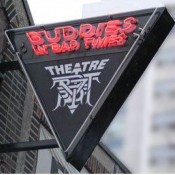New to the festival this year, Mobile Works take Rhubarb out in to the city – Life & Limb had a chat about their Mobile Works show k[NO]w places, private behavior, and how performances and audiences can change when you put them in a public space.
What creative process did you undergo to develop k[NO]w places?
The individual members of the collective formed after collaborating during a workshop, directed by Guillermo Gómez-Peña and Roberto Sifuentes of La Pocha Nostra, in June of 2010. They have carried on the collective collaboration process, inspired by the methodology of La Pocha Nostra, to develop k[NO]w places. The Pocha process is image based and centered upon exploring issues of embodiment, particularly as it connects to the borders of our identity. It is through imagery that our script develops, rather than the other way around. These tenants form the core of our process.
What challenges does a mobile performance piece pose?
The primary challenge is unpredictability. The unknown and often unsuspecting audiences members can often (re)direct the energy and even the trajectory of a performance. The inverted performance of spectatorship during a mobile performance can produce beautiful moments of improvisation; it can also produce anxiety since there is pressure upon the performers to keep the passerby engaged enough to stop and watch the performance. In addition, the weather, especially in February, can provide undesired challenges for performers; it can also influence the very presence of an audience.
Why have you chosen to explore the boundaries between public and private in your performance?
It was important for us to bring private acts into public spaces because there is a sort of blind faith most of us have in the scripts of public urban spaces, which, by virtue of being social spaces, condition how we function in them; there is an assumption that this conditioning is beyond our control. What happens when we take strategic control of this space? What happens when we explore other modes of being in public? We felt that the most obvious way to explore that is to invert the public by juxtaposing it against the private. The purpose is to democratize, even if it is for a movement, this social space that many of us take for granted.
What expectations do you have from your audience?
We hope that our performance is provoking enough for audiences to identify and question their own behaviour in public spaces; to reflect upon and engage in other ways of relating to public spaces; and to make conscious the implicit and often arbitrary borders we place between modes of being. In simpler terms, we want the boundaries between the interior and the exterior to be explicit and, in turn, to be questioned.
What inspired some of the images that are present in this performance?
Ultimately, our personal negotiations through public/private space have inspired our personas. These include: the voyeur, which sits at the border of public/private divide; an embodiment of violence, as it relates to the privatization of femininity and masculinity upon the queer male body; the masquerade of beauty and the vanity which conditions our movements; the performance of war upon the body; and the public scripts we perform at our most intimate moments. These personas, in a number of ways, give the audience a public glimpse into the private lives of the performers.
Visit the Life & Limb website or find programming info for k[NO]w places and other Rhubarb details online here.

